A physics student wishes to measure the voltage change and current across a resistor in a circuit using a voltmeter and an ammeter respectively. How should the student connect the voltmeter and ammeter to the circuit?
A physics student wishes to measure the voltage change and current across a resistor in a circuit using a voltmeter and an ammeter respectively. How should the student connect the voltmeter and ammeter to the circuit?
College Physics
10th Edition
ISBN:9781285737027
Author:Raymond A. Serway, Chris Vuille
Publisher:Raymond A. Serway, Chris Vuille
Chapter18: Direct-Current Circuits
Section: Chapter Questions
Problem 10P: Consider the circuit shown in Figure P18.10. (a) Calculate the equivalent resistance of the 10.0-...
Related questions
Concept explainers
Ohm's law
Ohm’s law is a prominent concept in physics and electronics. It gives the relation between the current and the voltage. It is used to analyze and construct electrical circuits. Ohm's law states that the voltage across a conductor is directly proportional to the current flowing through it.
Path of Least Resistance
In a series of alternate pathways, the direction of least resistance is the actual or metaphorical route that offers the least resistance to forwarding motion by a given individual or body.
Question

Transcribed Image Text:QUESTION 4
A physics student wishes to measure the voltage change
and current across a resistor in a circuit using a voltmeter
and an ammeter respectively. How should the student
connect the voltmeter and ammeter to the circuit?
a. The voltmeter should be connected in series with
the resistor, and the ammeter should be
connected in series with the resistor.
O b. The voltmeter should be connected in series with
the resistor, and the ammeter should be
connected in parallel with the resistor.
C. The voltmeter and ammeter should be connected
in a series combination that is, in turn, connected
in parallel with the resistor
d. The voltmeter should be connected in parallel with
the resistor, and the ammeter should be
connected in parallel with the resistor.
e. The voltmeter should be connected in parallel with
the resistor, and the ammeter should be
connected in series with the resistor.
Expert Solution
This question has been solved!
Explore an expertly crafted, step-by-step solution for a thorough understanding of key concepts.
This is a popular solution!
Trending now
This is a popular solution!
Step by step
Solved in 2 steps with 1 images

Knowledge Booster
Learn more about
Need a deep-dive on the concept behind this application? Look no further. Learn more about this topic, physics and related others by exploring similar questions and additional content below.Recommended textbooks for you

College Physics
Physics
ISBN:
9781285737027
Author:
Raymond A. Serway, Chris Vuille
Publisher:
Cengage Learning

Glencoe Physics: Principles and Problems, Student…
Physics
ISBN:
9780078807213
Author:
Paul W. Zitzewitz
Publisher:
Glencoe/McGraw-Hill

College Physics
Physics
ISBN:
9781305952300
Author:
Raymond A. Serway, Chris Vuille
Publisher:
Cengage Learning

College Physics
Physics
ISBN:
9781285737027
Author:
Raymond A. Serway, Chris Vuille
Publisher:
Cengage Learning

Glencoe Physics: Principles and Problems, Student…
Physics
ISBN:
9780078807213
Author:
Paul W. Zitzewitz
Publisher:
Glencoe/McGraw-Hill

College Physics
Physics
ISBN:
9781305952300
Author:
Raymond A. Serway, Chris Vuille
Publisher:
Cengage Learning

College Physics
Physics
ISBN:
9781938168000
Author:
Paul Peter Urone, Roger Hinrichs
Publisher:
OpenStax College


Physics for Scientists and Engineers: Foundations…
Physics
ISBN:
9781133939146
Author:
Katz, Debora M.
Publisher:
Cengage Learning